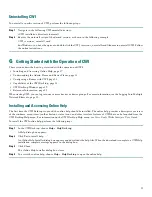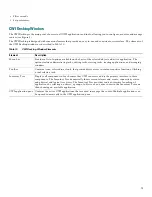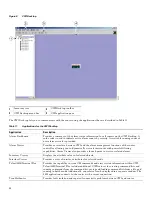
5
Enabling the HTTP Server
To download and install CWI, you must enable the HTTP server on the device.
Note
The HTTP server is used only to install CWI. After installation, the server can be deactivated.
To activate the HTTP server, install the manageability PIE, and add the configuration, use the
http server
command in global
configuration mode, as shown in the following example:
RP/0/RP0/CPU0:router#
configure
RP/0/RP0/CPU0:router(config)#
http server
In addition, you can enable SSL by using the
ssl
keyword from the
http server
command in global configuration mode, as shown
in the following example:
RP/0/RP0/CPU0:router#
configure
RP/0/RP0/CPU0:router(config)#
http server ssl
Setting Up the Common Configuration for IP Connection Methods
For CWI to manage the device through an IP connection method (for example, Secure Shell Version 1 [SSHv1], Secure Shell
Version 2 [SSHv2], or CORBA) one or more of Telnet, SSHv1, and SSHv2 must be active on the router, regardless of which main
connection method you are using. The default number of available virtual terminal lines (vtys) is relatively small. We strongly
recommend that the number be increased to allow several management sessions to run simultaneously.
To set the maximum number of vtys, use the v
ty-pool
command in global configuration mode, as shown in the following
example:
RP/0/RP0/CPU0:router#
configure
RP/0/RP0/CPU0:router(config)#
vty-pool default 0
max vty
For more information, see
Cisco IOS XR System Management Command Reference
.
Enabling the Telnet Server
To enable the Telnet server on a device for CWI, use the
telnet server
command in global configuration mode. The following
example shows that you can set the default VPN routing and forwarding (VRF) instance name for the Telnet server, specify the
IPv4 address prefix, and either specify the maximum number of Telnet servers or specify no limit to the maximum number of
Telnet services:
RP/0/RP0/CPU0:router#
configure
RP/0/RP0/CPU0:router(config)#
telnet vrf default ipv4 server max-servers [no-limit | 1-200]
For more information, see
Cisco IOS XR IP Addresses and Services Command Reference.
Enabling the SSH Server
Before you begin to enable the SSH server, ensure that you have generated the Rivest, Shamir, and Adelman (RSA) key pair for
SSHv1 and Digital Signature Algorithm (DSA) key pair for SSHv2, as described in the “Setting Up the Minimum Crypto
Requirements” section on page 6. To enable the SSHv1 server and SSHv2 server, use the
ssh server
command in EXEC mode,
as shown in the following example:
RP/0/RP0/CPU0:router#
ssh server
You can set both the rate limit and session limit options for the SSH server. For more information, see
Cisco IOS XR System
Security Configuration Guide
.






































